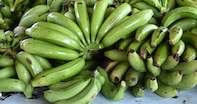Scientific name: Musa acuminata and Musa balbisiana
Common Name: Banana
Banana Plant Description
Banana is a herbaceous tropical fruit plant. It originated from the South West Pacific regions and islands. The first documented evidence of its spread was to India by about 550 BC and thereafter it quickly spread to all other tropical regions of the world. It is one of the world's oldest cultivated crops. It is said to have spread into West Africa by around 200 BC.
The banana plant grows to about 8 m tall. It has a true stem which forms underground above the extensive root system called a “corm”.
From this, a pseudostem grows and forms above ground made up of the bases of the leaves that form a crown of large supple elongated oval leaves that grow to 3 meters long and about 600 mm wide at its widest section, the leaf is supported by a prominent rib.
Stalks that bare the flowers grow up the centre of the pseudostem from the corm. The flowers mature into fruit that are formed into bunches made up of hands of fruit fingers, the bananas. From the time the flowers appear, it normally takes about 75 to 90 days for the fruit to be ready for harvest.
Banana Uses
There are many uses for banana flesh and skins. The leaves are also utilized. The main use we are dealing with is the fresh consumption of the fruit. It can also be cooked and dried. What also makes bananas so popular, other than its health properties, is that it has a sealed skin which makes for a healthy, safe food product without having to package or wrap.
Soil Requirements and Preparation
The banana plant enjoys an organic rich, well-drained soil. It prefers a slightly acidic soil and tolerates soil pH from 4.5 to 6.5. It does not tolerate high soil salinity at all.
Climate
The banana plant is a tropical plant and requires a large amount of rainfall spread over the year where relative humidity is above 85%. At least 2750 mm per annum otherwise irrigation should be supplemented. The average temperature should be about 28°C but during fruit ripening the plant prefers slightly cooler temperatures of between 22°C and 24°C.
Cultivars
There are over hundreds different varieties of bananas that grow around the world for various uses. For commercial production there are two main groups of bananas that are cultivated for the fresh market consumption around the globe.
The Cavendish banana group, that is the biggest commercially grown banana, is represented by the following varieties: Chinese, Grand Nain, Hamakua, Valery and Williams.
The Brazilian bananas are made up of the Dwarf Brazilian, Bluefields and Dwarf Bluefields.

